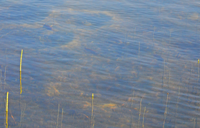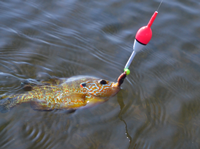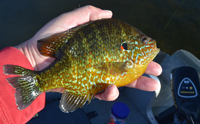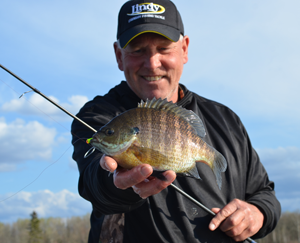Well I’m gonna do that right now, but I’m gonna be cautious because one of my responsibilities is to tell you that I KNOW something. Harvesting Sunfish off of their spawning beds is Not Cool.
Knowing that seeing a man headed for the soap box is liable to send folks rushing toward the exit sign, I’m gonna do my best not to preach. Instead, I’m gonna give you some solid information and then hope like heck that I’ve earned your respect enough so that you’ll take my advice.
Luckily, we can still eat plenty of sunfish, in fact we can eat as many as we want provided we eat the right ones. All we have to do is avoid targeting the Bulls that are on their beds, protecting their territory.
The way sunfish operate during the spawning season is incredible and makes a fascinating story; it would be a great movie.
You know how you're always running into that one guy, the one who’s cocky and arrogant, and the guy who always has to be "the prettiest rooster in the yard? Well that’s how male sunfish behave during the spawning season.
A good nickname for a young male sunfish could be “Vinnie Testosteronee”, a flashy young buck that lives for one reason; to reproduce. In fact these small male sunfish want to “do it” so bad that they can’t wait to grow up. These small bucks are waiting in line for a chance to knock off that big bull that’s protecting his spawning bed.
The bulls, the really big ones, devote weeks at a time protecting the beds, doing their best to keep those little interlopers away. They work so hard at it that they become too vulnerable, giving us anglers too much advantage. If we wanted to completely wipe them out, all we’d have to do is toss a lure into their bed and watch them do what comes naturally.
The only thing that saves any of these large, male sunfish is that we can’t find all of them. If we could, they’d already be gone and in many lakes, they already are gone.
Once the population of large fish disappears, the size structure continues to ratchet down. As the big bulls, keep getting smaller, so do the young bucks and after a while, there's nothing left except for small ones. Angler’s expectations become lower, they keep smaller and smaller fish until at at some point, the fish population becomes so badly stunted that fishermen don’t even bother trying anymore, they just move on to another lake.
If you really want to have your fish and eat them too, then think about this. The better strategy for gathering "eater fish", would be to focus on the smaller fish. Forget about fishing on the beds and target the females that wait in nearby cover as the urge to spawn attracts them into the beds. Here too, you'll find smaller males who are fidgeting and carrying on while they try to figure out a way to knock off Mr. Big from his bed.
A good strategy for locating “eaters” is to use the spawning beds as a marker for the territory. Then look nearby for Lily Pads, tree roots, weeds, anything that provides cover for the fish that are not sitting on the beds. You’ll know you’re on the right track, these fish are aggressive and sometimes come rushing your lure like a mob.
Catching them is not hard, small jigs like a little nipper tipped with small cut pieces of worms or leeches will do the trick. You can catch some fish by using an ultralight and fan casting tiny jigs, but often the water is so shallow that you’ll want to use a float.
Now all you have to do is have fun, be respectful of which fish you harvest and let nature take care of the rest. Yes, I understand that somebody might see you with a bunch of 8 inch sunfish and think that you’re silly for keeping them. But what they don’t know won’t hurt them; you do not have to let them find out that you are smarter than they are.
Oh and in a few years, when you still have a spot to fish and they don’t, you can torment them by allowing the aroma of your fish fry to drift over into their yard. They’ll like that!! |
 For locating “eaters”, use the spawning beds as a territory marker. Look nearby for Lily Pads, tree roots, weeds, anything that provides cover for the fish that are not sitting on the beds. For locating “eaters”, use the spawning beds as a territory marker. Look nearby for Lily Pads, tree roots, weeds, anything that provides cover for the fish that are not sitting on the beds.

Small jigs tipped with cut pieces of worm, suspended below a float is all you need.

Having your fish and eating them too can be easy. Sunfish like this 8 inch Red Ear might not be headed for the taxidermy, but they sure are tasty.
|

 For locating “eaters”, use the spawning beds as a territory marker. Look nearby for Lily Pads, tree roots, weeds, anything that provides cover for the fish that are not sitting on the beds.
For locating “eaters”, use the spawning beds as a territory marker. Look nearby for Lily Pads, tree roots, weeds, anything that provides cover for the fish that are not sitting on the beds.
